

| All terms and definitions submitted will be reviewed for accuracy and clarity before being added to this glossary. CCAA would like to thank the following for helping make this glossary a reality: Ed Glenn & Greg Keats, authors of "Turning Custom Duck and Game Calls". Doug Lodermeier, author of "Minnesota Duck Calls, yesterday's and today's folk artists". Bob Christensen, author of "Duck Calls of Illinois 1863-1963". Jim Thompson, Bob Christensen & John Fleck for their knowledge, time and support. Navigation hint - Click on one of the links below to take you to the definition. |
| A - arkansas style call B - ball ~ balloon ~ band ~ band saw ~ barbell ~ barrel ~ bead ~ bell ~ belt sander ~ bench grinder ~ bits ~ box call ~ butterfly C - checkering ~ chop saw ~ collet chuck D - dead center ~ diaphragm call ~ drill chuck ~ double reed ~ drill press E - F - free-form ~ friction call G - glodo ~ glodo barrel ~ guts H - handpiece ~ headstock ~ hollow ground I - insert J - jam chuck K - keg L - laminating ~ lanyard ~ lanyard grove ~ lips ~ live center ~ Louisiana style call M - mandrel ~ morse taper N - nibs O - oil ~ orbit |
| P - plug ~ pot call Q - R - reed ~ reelfoot style call ~ riving ~ rough out gouge S - sanding sticks ~ segments ~ skew chisel ~ sleeve ~ spigot chuck ~ spindle ~ spindle gouge ~ squawker ~ step drill bit ~ step-drilled barrel ~ step-drilled insert ~ stippling ~ stopper ~ straight parting tool ~ swing T - tailpiece ~ tailstock ~ tailstock quill ~ tone board ~ tone channel ~ tongue ~ tongue pincher ~ turning square U - V - varnish W - wedge ~ wedgeblock X - Y - Z - |
AArkansas Style Duck Call: A call with a curved tone board and a flatreed. The wedge slot is incorporated into the tone board. This type of call allows the assembly of the reed and cork positioned to the back of the slot for a more precise location and relocation of the reed in relationship to the tone board. 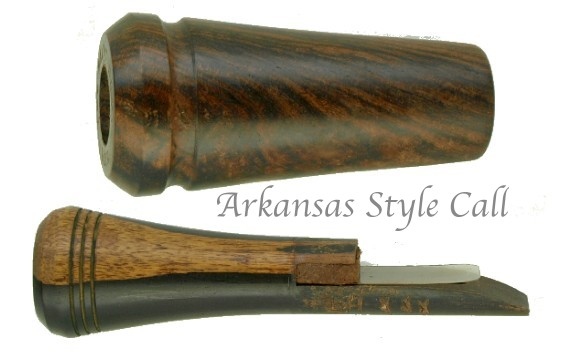 |
BBall: Embellishment where inserted dowel will be perpendicular to finished surface so visible end will be round. Balloon: Embellishment where inserted dowel is not perpendicular to finished surface and visible end will be oval or egg-shaped. Band: Embellishment of contrasting wood or metal piece encircling thebarrel or stopper of a game call . Metal bands, such as brass, may have both decorative and functional purpose.  Band saw: Power tool with narrow continuous blade essential for creating embellishments, such as orbits, wedges and butterflies. Barbell: Embellishment where inserted dowel is near edge of finished surface so both visible ends are joined by a narrow portion of the side of the dowel. Barrel: A tube or cylinder of wood or other material into which an insertis placed.  Bead: Common spindle turning feature of continuous radius convex shape. Bell or Tone Bell: Another name for a stopper. Belt sander: A stationery power tool with a continuous belt of abrasive material running over a flat platform. May be used for sanding wood parts and sharpening lathe tools to a flat bevel. Bench grinder: A stationery power tool with round grinding stones, usually on both ends of a motor shaft. Commonly used to sharpen lathe tools. Bits: See nibs. Box call: A friction call assembled from an open top box and paddle lid - which when drawn across the open top creates the game sound. Traditionally designed for turkey calls but is also used for a variety of goose calls. 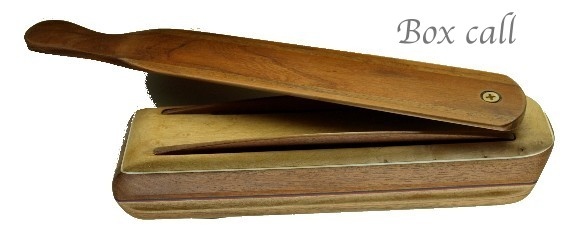 Butterfly: An embellishment created by inserting an inlay narrow in the middle and wider on each side. |
CCheckering: A decorative cross-hatch pattern consisting of a series of parallel intersecting lines or shallow grooves carved on the barrel or stopperof a call. Usually found as triangular-shaped checkered panels. 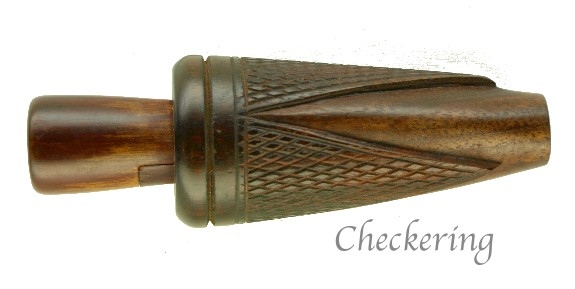 Chop saw: A power tool commonly used to saw wood strips to length. Collet chuck: A lathe chuck consisting of a body, collets of various sizes and a threaded ring, all designed to hold cylindrical turning objects with a diameter equal to a collet size. |
| D Dead center: A tailstock center that does not rotate with the work being turned. Diaphragm call: A game call that creates sound from the vibration of a thin, flexible diaphragm without the aid of a tone board.  Drill chuck: A chuck designed to hold a variety of sizes of hardened steel drills or bits. Double Reed Call: A duck call that employs two reeds, one on top of the other, which vibrate simultaneously to produce a raspier sound than a single vibrating reed. 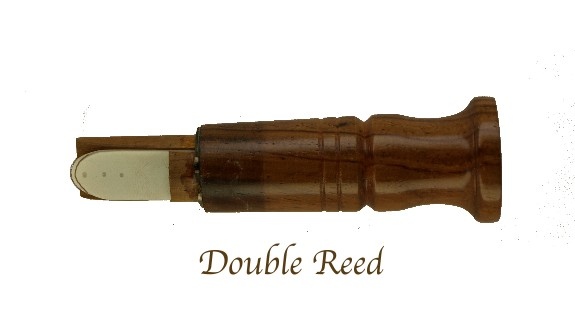 Drill press: A stationary drill motor with a movable spindle to hold a drill chuck, designed to drill vertical holes. |
E |
FFree-form: A specialized form of laminating where the pieces are cut along a free-form line. 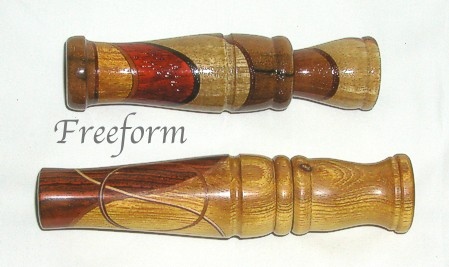 Friction call: A game call that produces a sound by rubbing a striker against another surface. |
GGlodo style duck call: The Glodo has a flat tone board stopper, a curved metal reed and a wedgeblock.  Glodo barrel: Has a sound cavity created in the barrel. This cavity has a larger diameter than either end of the hole through the barrel. Guts: Generalized description referring to any internal parts of the call. 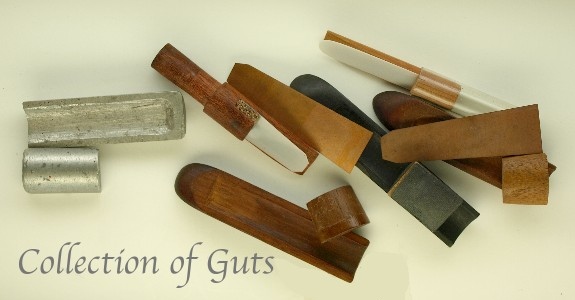 |
HHandpiece: As part of a game call, another name for the stopper. As a tool, a power driven, air or electric, hand held tool that holds the cutting burr used for wood carving and engraving. Headstock: The part of a lathe that delivers rotation, speed and power to the spindle. Hollow ground area: When you grind a tool against a round stone, the ground surface of the tool matches the round stone in reverse. The ground surface is not flat, but "hollow" as a mirror image of the round circumference of the stone. This is extremely important with lathe tools because a truly flat bevel is much easier to get a "rubbing" cut than with a hollow ground bevel. The larger the stone, the less the hollow ground effect is, and the bevel is closer to being flat, and easier to get a fine rubbing cut. |
IInsert: Any stopper that is preassembled as a single cohesive unit before it is placed into a call barrel. 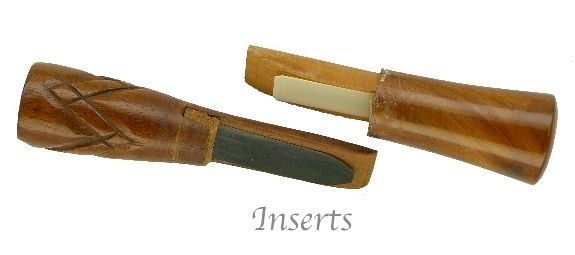 |
JJam chuck: A turning chuck, usually shop built, that fits tightly either inside or outside another turning to hold the second turning for work on its reverse side. |
KKeg: See stopper. |
LLaminating: The process of gluing several woods or other materials together so that a contrasting, decorative geometric pattern is created. The term applies especially to calls made from thin layers of wood bonded in the form of plywood but also includes specialized forms such as segmented andfree-form. 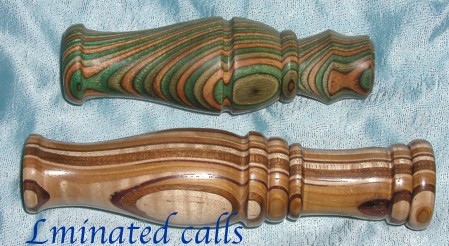 Lanyard: A cord or braid to hang a game call around the neck or attach to clothing for easy access and secure keeping. 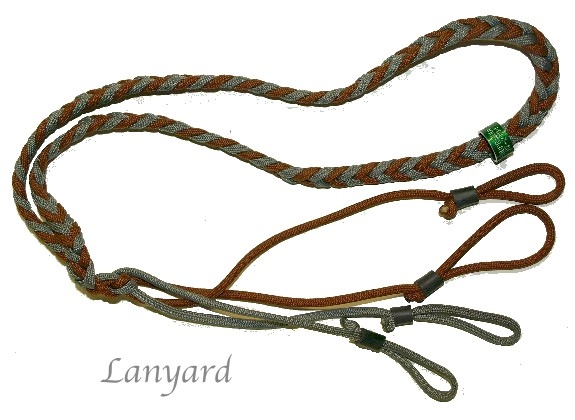 Lanyard Grove: A grove in the barrel and/or stopper intended to accept a lanyard. 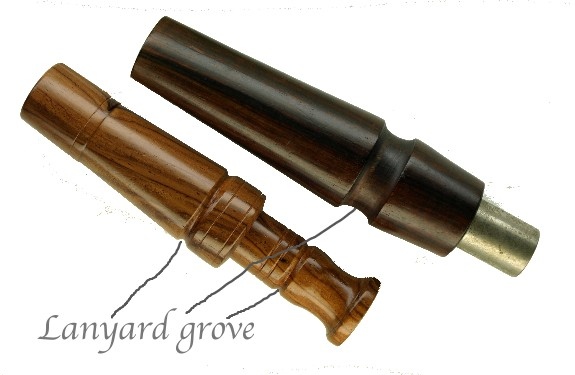 Lips: See Nibs. Live center: A tailstock center which includes bearings so it turns with the work. Louisiana-style duck call: A type of duck call that has an insertcomprised of a retaining tube into which is placed a curved tone board, a flatreed and a wedge. The components are fitted together and inserted as an assembly into the barrel. 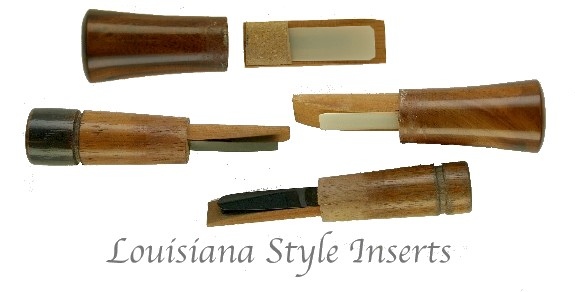 |
MMandrel: A rod or devise that passes through the center bore of a game call barrel or stopper and mounts (usually) between centers in a lathe. It must have some means of creating sufficient friction inside the game call part to allow turning its outside. Morse Taper: A system of holding tapered inserts inside identically tapered hollow spindles that allows transmission of rotation from the spindle to the insert without slippage. Inserts can be easily inserted and removed with little lateral force. |
NNibs:Two opposing external tone boards enclosing the reed, that forms the mouth piece of a crow call or hawk call. Also called "bits" or "lips."  |
OOil: A wood finish that is primarily absorbed by the wood. Orbit: An embellishment in which a call blank is sawn apart from side to side and reglued with a thin material in the saw kerf. In the finished call, only the edge of the inserted material appears as an inlay around the call. |
PPlug: Another name for a stopper. Pot call: A round bowl-like turkey call with a friction surface that is struck by a striker. The friction of the striker against the friction surface creates a sound like that of a hen turkey. 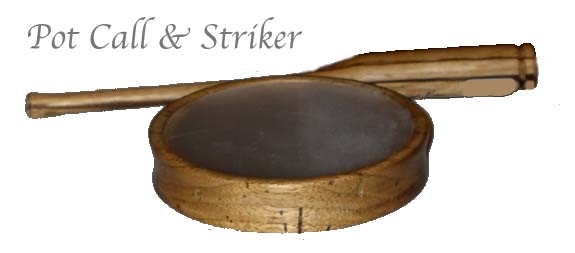 |
Q |
RReed: A thin flexible material made from metal, hard rubber, or plastic, that vibrates against the tone board in typical duck, goose and similar game calls. The size, shape and material of the reed and the shape and material of the tone board all contribute to the sound of the call. Sometimes called atongue. 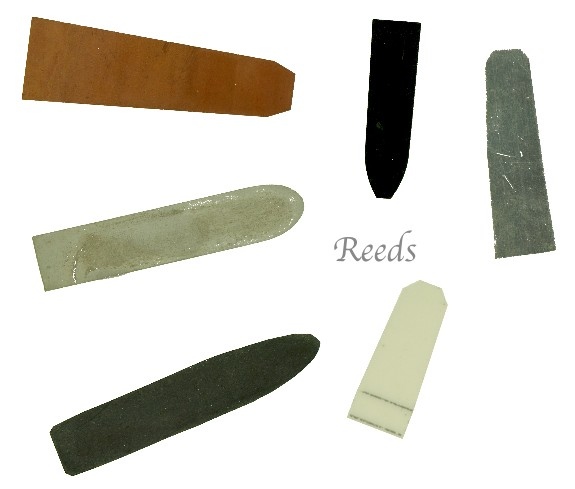 Reelfoot style duck call: Often used interchangeably with glodo style, but to many collectors suggests a metal reed Glodo style insert of relatively large size.  Riving: Splitting straight grained wood into manageable sizes and shapes. Rough out gouge: A heavy lathe tool of semi-circular cross section usually used to rough turn square or irregular shaped work to a cylinder. |
SSanding sticks: Dowels, both cylindrical and shaped, covered with abrasive and used either by hand or in the lathe to shape and sand game call parts. Segments: A specialized form of laminated where the pieces are cut to form segments of a circle. 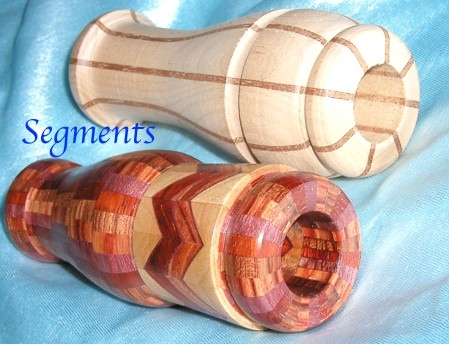 Skew chisel: A lathe tool with a rectangular shaft ground both sides to a cutting edge not square to the sides. Sleeve: A metal or wood tube inserted in the barrel to re-enforce the barrel and provide a more secure fit for the insert.  Spigot chuck: A lathe chuck with broad, rounded jaws designed to grip turnings either inside a recess or outside a cylinder. Spindle: The turning shaft of a lathe headstock or the shaft of a drill press. A lathe spindle is often threaded on the outside and Morse Taper ground on the inside to accept a variety of chucks and other accessories. Spindle gouge: A lathe tool of semi-circular cross section, often ground to a fingernail shape. Essential for cutting coves. Squawker: An early form of duck call that is similar to the Louisiana type but without the retaining tube. This type of call generally has an elongatedtone board. 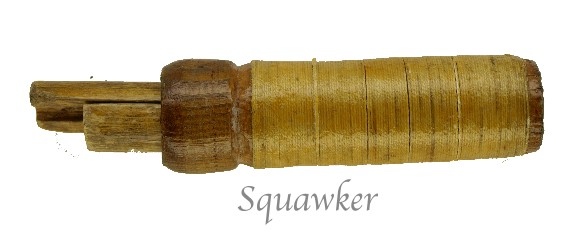 Step drill bit: A wood drill bit that increases the diameter of the hole as the bit drills into the wood. A common step drill will go from 1/8" dia. to 1/2" dia. in 1/32" steps. 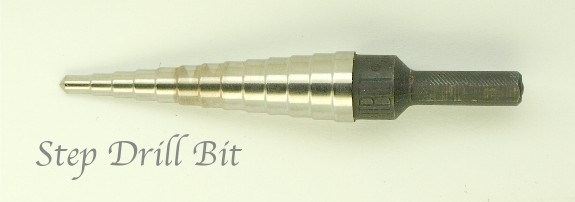 Step-drilled barrel: A call barrel whose interior bore is formed first by drilling the entire length to one diameter and them by using a larger diameter bit to drill a portion of the previous bore to a slightly larger diameter, creating an expanded chamber with the barrel in which the reed vibrates. This process is not to be confused with using a step drill bit to open the exhaust of an insert. Step-drilled insert: Using a step drill bit to open the exhaust of aninsert. Stippling: A decorative pattern consisting of dots, which are often formed by denting a call barrel with repeated shallow impressions, usually made by striking a punch, nail or similar instrument with a hammer. Current methods include the use of electric or air driven power tools with small burrs. 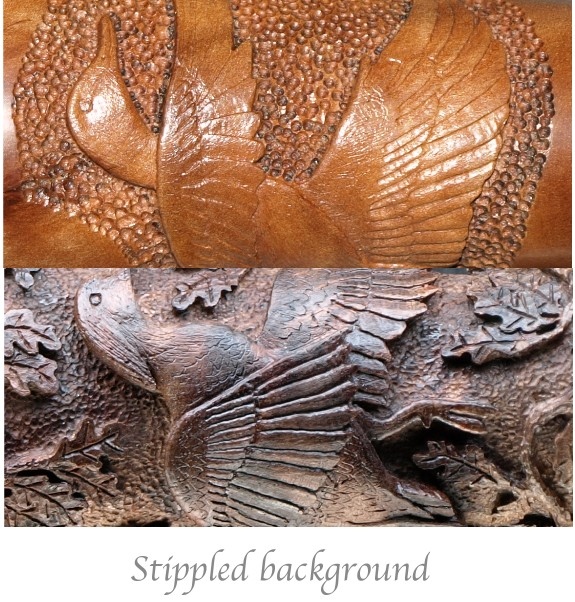 Stopper: The portion of a call that is inserted into a barrel, including thereed, tone board and wedge or wedgeblock. Other names that have been used for this part of the call include "plug," "tonal plug," "horn," "bell," "stem," "butt piece," "keg," "tailpiece" and "insert". 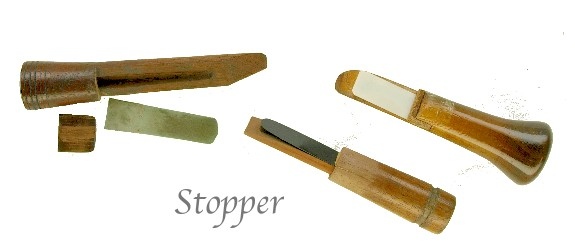 Straight parting tool: A lathe tool of rectangular cross section ground on both edges to a square cutting edge as wide as the cross section is thick. Swing: The maximum diameter of a turning that will clear the bed of a lathe. |
TTailpiece: Another name for a stopper . Tailstock: The part of a lathe opposite the headstock that provides support to the non-driven end of the work. The tailstock may also hold accessories like drill chucks. Tailstock Quill: Part of a tailstock that holds a center, usually with an MT insert, and advances against the work by way of an adjustment wheel or crank. Tone board: Part of a stopper that contains the tone channel and surface upon which the reed rests and vibrates. Also called "sound board" or "tone block". 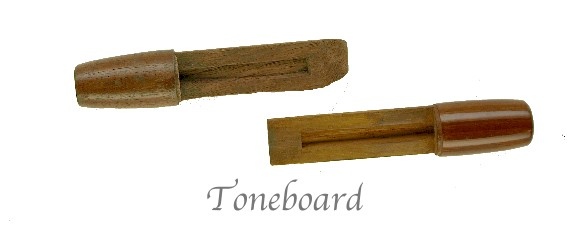 Tone channel: The trough created in the tone board that carries air under the reed to make it vibrate. Also called a "sound trough." 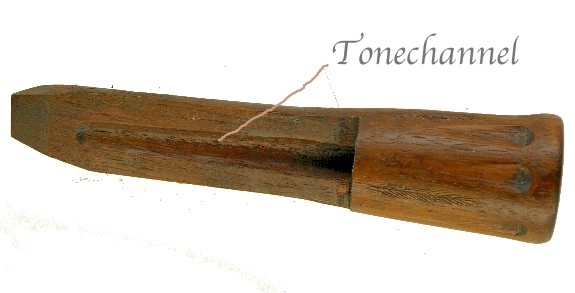 Tongue: see reed. Tongue pincher call: The earliest form of duck call. The name reflects the unfortunate characteristic this type of call has of pinching the callers tongue and lips when used. This call form is also known as the "Elam Fisher" style. 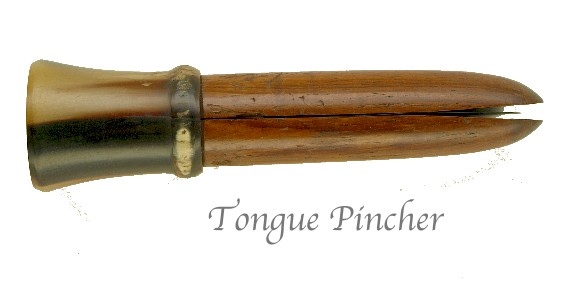 Turning square:A piece of sawn lumber, square in cross section and several inches long. |
U |
VVarnish: A category of wood finishes that primarily lie on the surface of the wood. |
WWedge: In an Arkansas or Allen type insert, the piece of cork, wood, hard-rubber, or leather that holds the reed to the tone board.  Wedgeblock: In a Glodo type call, the piece of wood, cork, hard-rubber or other material that holds the reed to the tone board while simultaneously holding the stopper in the barrel.  |
X |
Y |
Z |